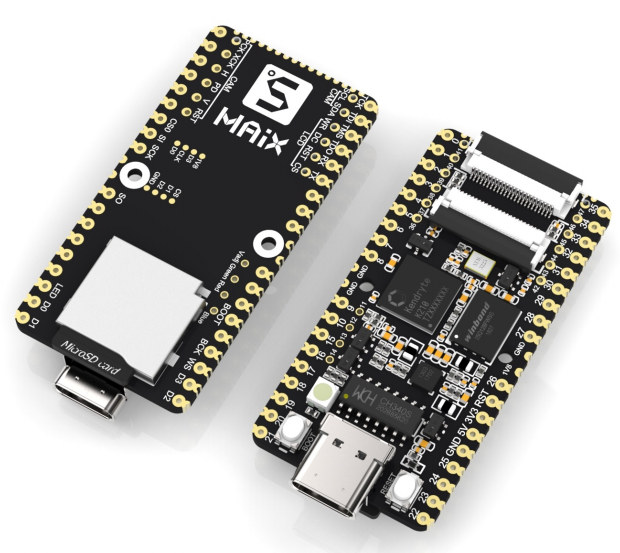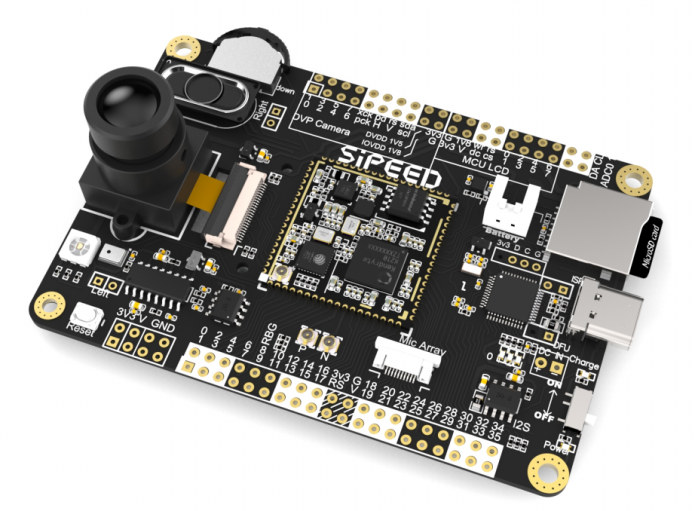Sipeed M1 (aka MAIX-I)is a compact module based on Kendryte K210 dual core RISC-V processor designed for low power artificial intelligence workloads at the edge, such as face detection, object recognition, or audio processing.
The module and some development boards are available on Taobao for the Chinese market, as well as YOYCart for the rest of the world, but the company has now launched several MAIX boards based on M1 module through an Indiegogo campaign with price starting at just $5 a piece.
 Sipeed MAIX Bit (aka MAIX Micro) is the cheapest one at $5 (early bird) / $6 with the following specifications:
Sipeed MAIX Bit (aka MAIX Micro) is the cheapest one at $5 (early bird) / $6 with the following specifications:
- SoC – Kendryte K210 dual core 64-bit RISC-V processor @ 400 MHz (overclockable up to 800 MHz) with
- KPU CNN hardware accelerator
- APU audio hardware accelerator with support for up to 8 mics, up to 192 KHz sample rate
- FPIOA (Field Programmable IO Array) mapping 255 functions to all 48 GPIOs on the chip.
- 8 MB general purpose SRAM including 5.9MB usable as AI SRAM memory
- AXI ROM to load user program from SPI flash
- Storage – micro SD card slot, 8MB SPI flash
- Display I/F – MCU LCD FPC connector for optional 2.4″ display
- Camera I/F – DVP camera FPC connector
- USB – 1x USB type-C port for power and programming
- Expansion – Breadboard friendly headers with UART, IIC, SPI, I2S, PWM, etc…
- Misc – 2x buttons, RGB LED
- Power Supply – Via USB type-C port
- Performance + Power Consumption – 0.25TOPS @ 0.3W ,400MHz. 0.5 TOPS @ 800 MHz
- Dimensions – 5.08 x 2.54 mm
They also provide the M1 “Dan” Dock which I covered previously, so I’ll skip it in this post, as well as the full-featured MAIX GO board.
- SoC – Kendryte K210 dual core 64-bit RISC-V processor
- Storage – micro SD card slot
- Display – Optional 2.8″ LCD display
- Camera – Standard M12 lens DVP camera fitted to bottom or top of the board
- Audio – I2S microphone, speaker, Mic array connector
- USB – 1x USB type-C port for programming and power
- Expansion – All pins out via through holes
- Debugging – On-board JTAG & UART based on STM32F103C8 MCU
- Misc – RGB LED
- Power Supply – Via USB type-C port; Lithium battery management chip
- Dimensions – 88x60mm
The company also provide accessories for their boards include 2.4″ and 2.8″ displays, camera module, microphone and microphone array modules,
The MAIX boards and module support the original standalone SDK, FreeRTOS SDK base on C/C++, as well as a Micropython port called MaixPy with source code available on Github. You’ll find an overview of the board, and various vision and audio demo in the video below.
If you are interested, you can pledge $5 for MAIX Bit board, $16 for M1w Dan Dock suit with the dock, module, OV2640 camera, and 2.4″ QVGA LCD, as well as $22 for MAIX GO suit including the MAIX GO board, an M12 OV2640 camera, a 2.8″ QVGA LCD display, and a simple case. If instead you’d like Sipeed M1 module, they are offered in packs of 10 units for $55, unless you want the WiFi version for a total of $65. Various other rewards are provided check out the Indiegogo page for details. Shipping adds $5 worldwide, unless you select the $20 DHL option, and delivery is planned for November or December 2018 depending on the rewards.
Thanks to Gaiar for the tip.

Jean-Luc started CNX Software in 2010 as a part-time endeavor, before quitting his job as a software engineering manager, and starting to write daily news, and reviews full time later in 2011.
Support CNX Software! Donate via cryptocurrencies, become a Patron on Patreon, or purchase goods on Amazon or Aliexpress






Hi, I’m Orgmar, the founder of Sipeed. There is a description in the article, “6 MB general purpose SRAM, 2MB AI SRAM memory” is not correct,need change to : 8 MB general purpose SRAM, and 5.9MB of them can be used as AI SRAM memory.
I got this information from other pages about K210, but thanks for the correction, I’ll update the post.
Do you plan updating the laser-etched ISA on the lid to the correct one (RV64IMADFC, or RV64GC) ? : )
They changed it to RV64GC, in case you’re wondering.
Thanks for the heads-up! It’s good Sipeed care to keep their nomenclature consistent.
Why do you use crowdfunding, isn’t it expensive?
There are many sellers selling AI Thinker products, why not ask them help to sell it?
MAIX-BIT with WiFi might be great add on.
So Cool!
This makes more sense if you think of it more like a bigger ESP32 than a small ARM SoC. Or at least it does to me.
But an ESP32 without WiFi/BLE is unthinkable. Here, there are vague references to a WiFi option but it seems not to be a fundamental capability.
I think he just means the K210 is an MCU, not a SoC, and ESP32 was the first MCU to come to mind.
Regarding the WiFi, I believe it’s only on the modules (e.g. not available on the bit/micro), and M1 means no wifi and M1w means it has wifi. Buried in the indiegogo page it says “M1w module add wifi chip esp8285 on it”.
You’d be surprised the number of projects for the ESP8266 and ESP32 where the wifi and the BT aren’t used.
They’re just really nice SoCs that happen to have Wifi/BT on it (if you need it).
Orgmar is the Sipeed founder and also AI Thinker CEO 🙂
I’ve been playing around with the official KD233 dev board for the chip and it’s fun. I wish I’d waited for this and gotten all the toys in the MAIX Go bundle for $5 less, that binocular camera looks especially good to play with (and the maix boards probably even have functioning reset/auto programming circuits, unlike the official development board!). If you’re backing this project I recommend you go with an option with a camera and a display included, because when you start playing with AI doing face recognition onto a screen is a lot more fun feedback than just… Read more »
One would think that the bulk of the toolchains are usable from off of the RISC-V GitHub repo for the same…and if you’ve got the tools to build, including CMake, it should be a walk in the park to fix the oversight.
All in all, I’m looking forward to seeing how well Kendryte’s stuff compares to some of the other RISC-V stuff I’ve got at my disposal.
This board reminds me lichee pi zero. How can we program it?
allo orgmar
can the all-in-1 pack in indiegogo able to toggle a relay ?
Hello I am interested in building a riscV small computer, with cpu, 4 cores smp, mmu, gpu, vpu, pci, USB, 4gb of memory, some pio, sio, dma.. just like an raspberry pi. Must be a single board computer with power supply on board too.The system must run NetBSD.. market size: about 1,000,000 units.. how much money is needed to build this project??? Thanks for any help.
What you are trying to do will be challenging. First the RISC-V processor you describe does not exist yet, although it might come next year. So you’d have to wait or invest in the development of a new processor. I can see NetBSD has some RISC-V support, but obviously it won’t support this new RISC-V processor, and things like support for GPU, VPU on RISC-V is non-existing, so you’d have to support NetBSD software development. That means a team of SoC designers, hardware designers, software developers, QA, and so on. I’m unable to provide an estimate of the costs, but… Read more »
Sorry for the delay… I like challenge things… by the way…the idea is to produce a small computer able to run some sort of graphics on small GPU capable of running opengl. It must NOT be based on ARM because of the copyright, so my choices are RISCV and MIPS compatible cpu….. the idea is to offer those small computers to secod grade students in Brazil… about 25 millions… the small computers must have a gpu able to produce up to 1920×1080 utput via HDMI, 4 cores, 4 usb, about 4gb of memory, 64gb internal storage, a rapsberry pi interface… Read more »
You may get trouble getting software support for the MIPS processor, and I’m not sure they’ve fully made it open-source, although an initiative was started a while ago. So I’d still recommend going with RISC-V. Maybe I’ll try to put you into contact with a silicon vendor.
Since I really don’t recommend going with MIPS at this stage, I’ve talked with some people about doing it with RISC-V, and it will only be possible in 2023-2024 since the ecosystem is not mature. If you want to manufacture one million boards, I’m not sure about the development costs, but the BoM should be closer to let’s $30. So 30 million dollars just for components and the PCB. You can check any board manufacturers and silicon vendors like SiFive, StarFive, etc…, but you’d better have some investors or government backing before contacting them, because you may not be taken… Read more »
I’ve been told $5 million should be more than enough for development costs (e.g. not including manufacturing), as long as you don’t make your own chip.